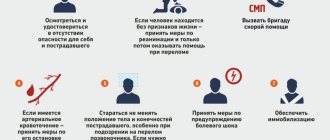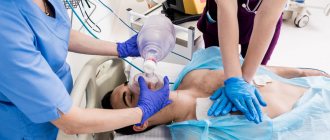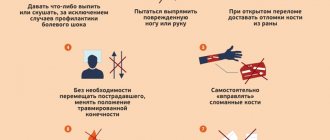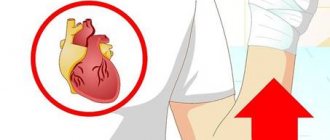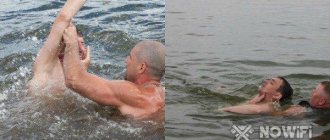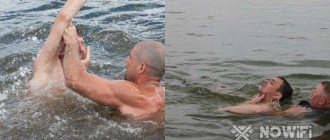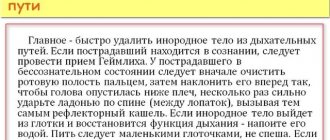A fracture is a bone injury that disrupts its integrity. Traumatic fractures are divided into open (there is damage to the skin in the fracture area) and closed (the skin is not broken).
With an open fracture, the injury is beyond doubt. A closed fracture is not so obvious, especially if it is incomplete, when part of the diameter of the bone is broken, often in the form of a crack.
All fractures are characterized by:
- sharp pain with any movements and loads;
- change in the position and shape of the limb, its shortening;
- dysfunction of a limb (impossibility of usual actions or abnormal mobility);
- swelling and bruising in the fracture area.
Providing first aid for fractures of the extremities largely determines the outcome of the injury: the speed of healing, the prevention of a number of complications (bleeding, displacement of fragments, shock) and has three goals:
- creating immobility of bones in the fracture area (which prevents displacement of fragments and damage to them by the edges of blood vessels, nerves and muscles);
- prevention of shock;
- prompt delivery of the victim to a medical facility.
First aid for a closed fracture
When providing first aid for a closed fracture, you should immediately contact an ambulance. After this, it is necessary to immobilize the broken limb and, if possible, apply ice or a cold object to the injury site. The person may be given a painkiller. When transporting independently, a splint is applied using available items: board, stick, ski, etc.
In the absence of available means, the injured limb is bandaged to the uninjured one. During transportation, the victim must lie down - the broken limb should be slightly raised.
Our clinics in St. Petersburg
Structural subdivision of Polikarpov Alley Polikarpov 6k2 Primorsky district
- Pionerskaya
- Specific
- Commandant's
Structural subdivision of Zhukov Marshal Zhukov Ave. 28k2 Kirovsky district
- Avtovo
- Avenue of Veterans
- Leninsky Prospekt
Structural subdivision Devyatkino Okhtinskaya alley 18 Vsevolozhsk district
- Devyatkino
- Civil Prospect
- Academic
For detailed information and to make an appointment, you can call +7 (812) 640-55-25
Make an appointment
An open fracture is a type of fracture in which damage to the skin or mucous membranes occurs. Open fractures of the extremities are more common. The main danger of open fractures is that various microorganisms penetrate through the wound, which can infect soft tissues, bone fragments and cause such serious complications as wound suppuration, osteomyelitis and even tetanus.
First aid for an open fracture
Such an injury is extremely dangerous, as the wound can become infected. First aid for an open fracture begins with stopping bleeding using a pressure bandage or tourniquet if significant blood loss is observed. Antiseptic preparations are used to treat the skin around the wound. To transport the victim, it is necessary to carefully apply a splint without touching the wound.
Prices for services
- Removing the plaster cast (splint) 660a
- Treatment of open fracture site 825a
- Removing the cellocast bandage 860a
- Application of an immobilization bandage for bone fractures 1320a
- Strengthening and correction of plaster, cellocast, turbocast bandages 1320a
- Application of a Turbocast (Orthosis) bandage without the cost of material 1320a
- Application of an immobilization bandage for spinal fractures 1760a
- Application of a small plaster cast (for injuries of the hand and foot) 2200a
- Closed manual reduction for fractures of small tubular bones 2640a
- Application of a medium plaster cast (for injuries to the bones of the forearm, radial joint) 3520a
- Application of a small cellocast bandage (for injuries of the hand and foot) 3850a
- Closed manual reduction for long bone fractures 4620a
- Application of a large plaster cast (for injuries of the shoulder, shoulder joint, knee joint) 5280a
- Application of a Turbocast bandage (Orthosis) for hand injuries 5390a
- Application of a medium cellocast bandage (for injuries of the forearm, lower leg) 6050a
- Application of a Turbocast bandage (Orthosis) for foot injuries 6160a
- Application of a large cellocast bandage (for injuries of the shoulder, knee joint) 7700a
- Application of a Turbocast bandage (Orthosis) on the wrist 14190a
- Application of a Turbocast bandage (Orthosis) to the ankle joint 19690a
- Application of a Turbocast bandage (Orthosis) to the elbow joint, knee joint 21890a
- Primary appointment (examination, consultation) with a traumatologist-orthopedist 1210a
The information and prices presented on the website are for reference only and do not constitute a public offer.
Types of fractures
Broken arm
First aid for arm fractures is based on prompt immobilization of the limb, application of a splint and fixation. Severe pain is relieved with painkillers. If pain shock begins to develop, the victim is warmed up and given hot tea. It should be noted that drinking is prohibited if the patient is vomiting or has an abdominal injury. When the symptoms of shock are eliminated, the injured person can be moved.
An open fracture of the arm requires stopping the bleeding using a tourniquet, which is applied above the injury. Antiseptics are used to treat the wound. Having stopped the bleeding and treated the wound, it is necessary to carry out the procedure of fixing the hand.
Attempts to realign bones are strictly prohibited.
Broken leg
First aid for leg fractures involves using a splint to secure the limb. An open injury may bleed, so stop the bleeding using a tourniquet. The wound is treated with antiseptics, and if the victim feels severe pain, anesthetics are used.
Independent attempts to straighten the bone are strictly prohibited.
Spinal fracture
A spinal fracture is a serious injury that threatens the life of the victim. For such a fracture, pain relief must be given very quickly, and the body must be fixed immediately. To move a person, boards, doors, and plywood are used. The head is fixed with a rigid collar made of suitable items.
It is prohibited to sit down, try to stand, pull the limbs, or straighten the spinal column of the victim.
Pelvic fracture
A pelvic fracture can be accompanied by severe complications and internal bleeding, which sometimes result in disability and death. When providing first aid in such cases, you should examine the victim, immobilize him in a supine position (knees should be bent), fix the pelvis, and raise the knees with a roller. In addition, the patient’s condition should be constantly monitored until doctors arrive.
It is forbidden to seat or try to position a patient.
Fractured ribs
When a rib is fractured, internal organs and the cardiovascular system can be damaged, which is very dangerous for the victim. However, a simple fracture of one or two ribs does not require the attention of specialists - the patient recovers on his own. In difficult cases, it is necessary to urgently hospitalize the injured person and provide him with qualified assistance.
This type of fracture requires rest, so it is worth limiting active movements and sports.
Tibia fracture
First aid for lower leg injuries consists of fixing the limb, applying a splint, and administering painkillers to the patient. If there is bleeding, a tourniquet is applied.
Repositioning the bone is strictly prohibited.
Shoulder fracture
A shoulder injury can be complicated by internal hemorrhage, which is extremely dangerous to health. The patient needs immobilization for a fracture using a splint, and he should also be given painkillers. The victim must be moved in a sitting position.
It is forbidden to straighten the shoulder and carry the patient without fixing the limb.
General classification of fractures and their characteristic features
The general classification of fractures is usually based on the degree of rupture (damage) to the bone. First of all, a distinction is made between complete and incomplete fractures, as well as open and closed, with and without displacement of bone fragments. It wouldn’t hurt to immediately voice the general signs on the basis of which a person is preliminarily diagnosed with a fracture:
- an arm, leg, spine or pelvis is deformed;
- severe pain in the damaged area;
- the position of the limb looks unnatural;
- hemorrhages and swelling are observed.
The main actions in such a situation are, if possible, to restore the integrity of the bone, stop the bleeding, if any, treat the wound with an antiseptic, immobilize the damaged limb and transport the patient to the trauma department of the hospital on an emergency basis.
Treatment
As you know, there are two methods of treatment - conservative and surgical. The first method is suitable for a closed type of injury, without fragments or significant damage to adjacent areas. The patient is placed in a plaster cast and prescribed a course of medications (painkillers, restoratives, calcium-containing). Depending on the severity of the damage, the time of wearing the cast varies from 3 to 10 weeks.
The presence of fragments or severe open fractures require surgical intervention and reduction. The individual parts of the bone are attached using special knitting needles, bolts and plate-shaped joints. At the final stages, cosmetic stitches are applied and a rehabilitation course is developed.
Classification
Bone damage comes in different forms, in different locations, and varies in severity. Modern medicine distinguishes the following categories:
- Type of fracture – closed, open (without or with a rupture of the skin, respectively).
- Location - on the bone itself (diaphyseal), near its end (metaphyseal) and at the very end (epiphyseal).
- Shape – longitudinal, transverse, screw-shaped, star-shaped, V- and T-shaped, crushed and splintered.
- The number of affected areas is one (only one bone is affected, which means an isolated type), two or more (multiple type).
- Fragments - cause displacement or not. The displacement itself also differs in its width, length and angle of inclination (it can be primary, if it occurs from a heavy load, and secondary, if caused by a muscle reaction).
The transosseous osteosynthesis method allows:
- carry out extrafocal fixation of the fracture (wires pass above and below the level of the fracture, leaving the area of the fracture and the soft tissue above it intact), which
- allows you to perform osteosynthesis in cases where internal fixation is contraindicated: open fractures, infected fractures, wound infection, osteomyelitis, etc.
- carry out correction of the position of fragments during treatment, staged reposition
- influence the callus by distraction and compression, stimulate bone fusion
- lengthen the limb due to the formation of a distraction regenerate (the method of increasing height using transosseous osteosynthesis is based on this)
- fix the most complex fractures (comminuted, crushed, etc.)
Currently, the indications for the use of the Ilizarov apparatus have been reduced in favor of internal fixation of fractures as a more patient-friendly treatment method. Indications for transosseous osteosynthesis are open, infected, complex comminuted fractures.
What not to do when immobilized
We have discussed in general terms how to provide first aid to a victim with fractures. Now, let's figure out how not to harm him.
Before immobilization, the victim should be checked for bleeding. If there is bleeding, first of all, you need to stop it.
After immobilization, your powers are over (even if you are a doctor, further work requires specialized conditions of a medical institution). This leads to an important conclusion: there is no need to try to set the bones. Also, do not try to carry the victim until the injured limb is fixed.
Rehabilitation
Includes:
- physiotherapeutic procedures - magnetic therapy, laser, light and ultrasound irradiation, as well as electrophoresis;
- gymnastics – gradual development of the arm, selection of a set of exercises, daily increase in load under the supervision of a rehabilitation physician;
- massages - to improve blood flow, restore muscle and ligament fibers.
Additionally attributed: mud baths, paraffin therapy, compresses, soaking in sea salt or decoctions of medicinal herbs.
Transosseous osteosynthesis with external fixation devices
A special place is occupied by external transosseous osteosynthesis, which is performed using distraction-compression devices. This method of osteosynthesis is most often used without exposing the fracture zone and makes it possible to perform reposition and stable fixation of fragments. The essence of the method is to pass wires or rods through the bone, which are fixed above the surface of the skin in an external fixation device. There are different types of devices (monolateral, bilateral, sector, semicircular, circular and combined).
In Russia, the Ilizarov apparatus is traditionally used as the most functional, convenient and reliable external fixation device. G.A. Ilizarov was the first to invent a device in which crossed spokes, passed through bone fragments, were fastened in a tense state to ring supports. In this case, the device is located outside the patient’s body.
